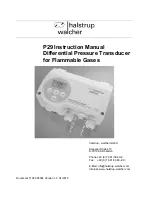
10
www.seektech.com
Ridge Tool Company
●
Elyria, Ohio
●
U.S.A
SeekTech ST-305 Line Transmitter
The transmitter’s maximum current output depends
on the amount of resistance in the circuit.
CAUTION
If the transmitter is showing low or no current (low
or no beep rate), the signal may be
too low to be
detected
by the receiver locator and inadequate for
tracing.
4. Check the Receiver.
Confirm that the transmitter and receiver are set to
the same frequency. Hold the receiver near the
transmitter cables and confirm a signal is being
received.
FCC Limits
47 CFR 15.213 requires that from 9kHz up to (but not
including) 45kHz, peak output power shall not exceed
10 W. From 45kHz to 490kHz, it must not exceed
1W. When the ST-305 is set to 262 kHz (European
version: 93 khz), the power output levels are limited:
Low
:
0.3 watt,
Medium
:
0.6 watt
High
:
1 watt.
These values assume a nominal load of 320 ohms.
Useful Operating Tips
•
The lower the resistance, the more current will
be put on the line. A good circuit is one that
allows enough current to flow so that the locator
gets a solid, clear signal.
•
To help lower the resistance of the circuit,
scrape away dirt, paint, and corrosion before
connecting to the target conductor or to the
grounding spike.
•
A good ground has lower resistance, which
allows more current and a stronger signal. For a
better connection to ground, insert the
grounding spike as far as possible. Moist
ground is a better conductor than dry soil, so try
wetting the area if necessary.
•
The transmitter’s leads can act as antennas,
broadcasting a strong signal. If locating close to
the transmitter, keep the leads short by stowing
the excess length on the transmitter’s body.
This will reduce the amount of interfering
signals from the leads. Where possible, place
the transmitter away from the area of the
intended locate. This is especially true in
Inductive Mode, to avoid coupling through the
air with the receiver.
•
Start by using the lowest frequency and the
least amount of current needed to effectively
illuminate the line. Lower frequencies travel
farther because they do not dissipate as
quickly. Higher frequencies generally make it
easier to illuminate a line, but they don’t travel
as far and are much more likely to couple onto
other utility lines, distorting the signal and
reducing the accuracy.
Dual-Frequency Transmission
The ST-305 can be placed in Dual-Frequency mode
by pressing the Frequency Key for over 1 second
(long press). To exit Dual-Frequency mode, simply
repeat the long press on the Frequency Key. See
Figure 8.
When in Dual Frequency mode the Frequency Key
will cycle with
short
presses through the following
frequency settings:
1.
262 kHz only (rapid flashing 33kHz LED)
(European version: 93 khz.)
2.
33 kHz and 1 kHz dual-frequency
transmission (LEDs for 33 kHz and 1 kHz
both lit).
3.
33 kHz and 8 kHz dual-frequency
transmission (LEDs for 33 kHz and 8 kHz
both lit).
Dual-Frequency transmission is available only in
direct connect mode.
Frequency Key Options
Short Press … Long Press
⎯
1 kHz
Dual Mode On
8 kHz
33 kHz
262 kHz (93 kHz in European
version)
Dual 33 kHz / 1 kHz
Dual 33 kHz / 8 kHz Dual Mode Off
Figure 8: Frequency Key Options




































